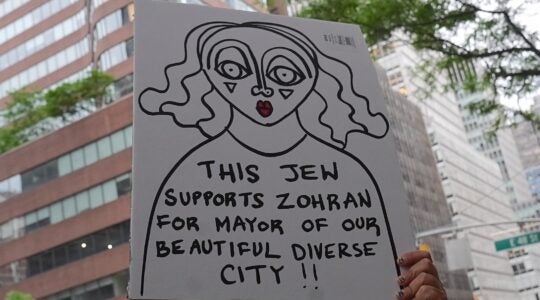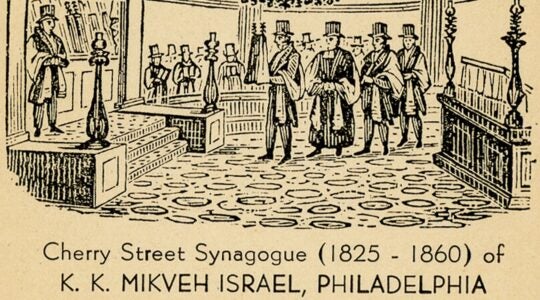How welcome, Rabbi Yitz Greenberg’s call to Modern Orthodox leaders to speak out for a new, better order at the Kotel (“Time For Modern Orthodox Leaders To Speak Out On Kotel Proposal,” Opinion, April 26).
How sad that his piece contains such misinformation about the Women of the Wall, and our goals before and after the Natan Sharansky proposal to create egalitarian prayer at the Kotel.
The Women of the Wall is an independent, unaffiliated group of religious women who wish to actualize for women the promise that restoration of the Kotel to Jewish hands in 1967 meant for men: we want the option of women’s group prayer, with Torah, tallit and tefillin in the women’s section at the Wall. That is it.
Our members and supporters are utterly diverse. The idea of first going to the Wall came from an Orthodox Talmud scholar from Brooklyn, Rivka Haut, in 1988. She wished to go there for a group prayer, with Torah reading. Weary of denominational divisions, she wanted, davka, a mixed group religiously, so appealed to others to join in an act of ahavat chinnam — gratuitous love and acceptance — whatever our religious differences, which were and remain manifold. If we joined together in that way, we would gain something none of us would otherwise have, and the sublimity of the day when that happened was precisely that: giving one another the gift of prayer in that place.
Thereafter, an Israeli, Bonna Haberman, initiated the Israeli group, which has gone to the Kotel on Rosh Chodesh unfailingly, rain, shine, cold, hot, for nearly 25 years — women rising early to be there for 7 a.m. tefillot.
As anyone with a modicum of Jewish learning knows, nothing we seek is forbidden under halacha (Jewish law). This is not, and never has been, about religion or halacha. It is about the rule of the fist, literally and legally, and sheer misogyny.
Before 1967, under Christian and Muslim rulers, down to the British and Jordanians, Jews had limited access to the Wall. We could not pray there in groups, with voice, or Torah, or blow shofar. That all changed in 1967 — for men — and many new customs began to be innovated there, as befits a free and sovereign people: minyanim round the clock, seemingly innumerable Torah scrolls, bar mitzvahs, weddings, the mass blessing of thousands of kohanim on festivals. The mechitza itself is an innovation at the Wall.
But the restrictions once enforced on all Jews are now enforced by regulation of the Ministry of Religion and, yes, the short-sightedness of the current rabbinic administration of the Wall, on women who are Jews. Haredi sensibilities are not just to be respected, as they should be, but enforced on everyone. Those sensibilities anathematize autonomous Jewish women: women who are not just daughters, mothers, wives of Jews, but Jews. In our own right.
We have not yet seen the final details Sharansky proposal. But from what we hear, and which Rabbi Greenberg celebrates, it proposes precisely that — the banishing of women from the Kotel. It is an old solution in a new guise. Ten years ago, the Women of the Wall were told to go to Robinson’s Arch; that would be an option for Reform and Conservative Jews, too, leaving the Wall in haredi control. We never accepted banishment to another site nor the proposal that the Wall be under a rabbinic administrator who denies the sensibilities and rights of the vast majority of Jews, suffering our presence only on his terms.
We welcome new options for prayer; if the Sharansky plan affords this, good. But an improved Robinson’s Arch is still Robinson’s Arch. It is not the site of 2,000 years of Jewish memory and longing and hope and loyalty to the promise of the return to Zion. The very stones tell that truth: those of the Kotel and Robinson’s Arch are indeed, as many, including Sharansky have noted, of the same provenance. Those of the Kotel, however, are worn smooth by centuries of Jewish devotion; those of Robinson’s Arch are rough as when they were hewn. Perhaps, in time, Jews will embrace other sites, but if so, that will not happen by fiat and certainly not because of banishment from the Kotel.
If having been sanctified by the yearning of Jews for 2,000 years makes the Kotel a “fetish” now, why care about ancient rocks a few meters away and make those a new place of devotion? For that matter, why make a “fetish” of Jerusalem, or the Land of Israel altogether, if place and historical memory do not matter?
The Sharansky plan proposes that anyone not practicing according to haredi custom go to (an improved) Robinson’s Arch. If Robinson’s Arch is indeed, “just like the Kotel,” why not have the haredim go there, as well — or instead?
Mixed-gender prayer services will do nothing for women who require women-only prayer; there is no solution for them at Robinson’s Arch. But we cannot sanction acceptance of the proposition that women doing these mitzvot desecrate the holy.
The Twelve Tribes crossed the desert under different flags, but we were told to build one mishkan (tabernacle). Rabbi Greenberg rightly rejects the current administration of the Wall’s definition of “unity” as its hegemony. We propose another model: unity in diversity, with mutual respect and accommodation. Not just at the Kotel, but precisely, at the Kotel..
Shulamit Magnus, a founding member of Women of the Wall, is associate professor of Jewish Studies and History at Oberlin College.
The New York Jewish Week brings you the stories behind the headlines, keeping you connected to Jewish life in New York. Help sustain the reporting you trust by donating today.




